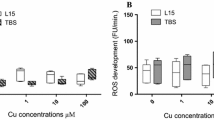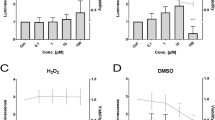Abstract
Bluegill sunfish BF-2 fibroblasts were used in the neutral red (NR) cytotoxicity assay to discern the toxicities of hydrogen peroxide (H2O2) and paraquat as indicated by their abilities to induce oxidative stress. The toxicity of H2O2 was markedly enhanced in BF-2 cells treated with the glutathione depleting agents, buthionine sulfoximine (BSO), maleic acid, and chlorodinitrobenzene; similar treatments did not sensitize the BF-2 cells to paraquat, a redox cycling xenobiotic. BSO treated BF-2 cells, however, were sensitized to nitrofurantoin, also a redox cycling chemical. Diethyldithiocarbamate, an ihibitor of superoxide dismutase, only weakly enhanced the sensitivity of the BF-2 cells to H2O2 and paraquat. 1,10-Phenanthroline, a chelator of Fe2+, reduced the cytotoxicity of H2O2 and paraquat, presumably by preventing hydroxyl radical formation in the Fenton reaction. Quin 2 AM, an intracellular chelator of Ca2+, markedly lessened the toxicity of H2O2, but not of paraquat; EGTA, an extracellular chelator of Ca2+, had no effect on the toxicity of H2O2 or paraquat. Apparently, perturbation of intracellular Ca2+ homeostasis is involved in H2O2 toxicity. For comparative purposes, some studies were performed with fathead minnow FHM epithelioid cells, BALB/c mouse 3T3 fibroblasts, and human HepG2 hepatoma cells. The BF-2 fibroblast/NR cytotoxicity red assay was shown to be a suitable model to study oxidative stress in fish.
Similar content being viewed by others
References
Andaya AA, Di Giulio RT (1987) Acute toxicities and hematological effects of two substituted naphthoquinones in channel catfish. Arch Environ Contain Toxicol 16:233–238
Arrick BA, Nathan CF, Griffith OW, Cohn ZA (1982) Glutathione depletion sensitizes tumor cells to oxidative cytolysis. J Biol Chem 257:1231–1237
Babich H, Borenfreund E (1991) Cytotoxicity and genotoxicity assays with cultured fish cells: a review. ToxicolIn Vitro 5:91–100
—, — (1992) Applications of the neutral red cytotoxicity assay to risk assessment of aquatic contaminants. In: Environmental toxicology and risk assessment, 1st Symposium. American Society for Testing and Materials, Philadelphia, PA, pp 241–255
Borenfreund E, Puerner, JA (1985) Toxicity determinedin vitro by morphological alterations and neutral red absorption. Toxicol Lett 24:119–124
Cantoni O, Sestili P, Cattabeni F, Bellomo G, Pou S, Cohen M, Cerutti P (1989) Calcium chelator Quin 2 prevents hydrogen peroxide-induced DNA breakage and cytotoxicity. Eur J Biochem 182:209–212
DiGuiseppi J, Fridovich I (1983) The toxicology of molecular oxygen. CRC Crit Rev Toxicol 12:315–342
Di Giulio RT, Washburn PC, Wenning RJ, Winston GW, Jewell CS (1989) Biochemical responses in aquatic animals: A review of determinants of oxidative stress. Environ Toxicol Chem 8:1103–1123
Di Monte D, Bellomo G, Thor H, Nicotera P, Orrenius S (1984) Menadione-induced cytotoxicity is associated with protein thiol oxidation and lateration in intracellular Ca2+ homeostasis. Arch Biochem Biophys 235:343–350
Di Monte D, Sandy MS, Ekstrom G, Smith MT (1986) Comparative studies on the mechanisms of paraquat and 1-methyl-4-phenylpyridine (MPP+) cytotoxicity. Biochem Biophys Res Commun 137:303–309
Gabryelak T, Klekot J (1985) The effect of paraquat on the peroxide metabolism enzymes in erythrocytes of freshwater fish species. Comp Biochem Biophys 8:1103–1123
Goldstein BD, Rozen MG, Quintavalla JC, Amoruso MA (1979) Decrease in mouse lung and liver glutathione peroxidase activity and potentiation of the lethal effects of ozone and paraquat by the superoxide dismutase inhibitor diethyldithiocarbamate. Biochem Pharmacol 28:27–30
Griffith OW, Meister A (1979) Potent and specific inhibition of glutathione synthesis by buthionine sulfoximine (S-n-butyl-homocysteine sulfoximine). J Biol Chem 254:7550–7560
Harlan JM, Levine JD, Callahan RS, Schwartz BR, Harker LA (1984) Glutathione redox cycling protects cultured endothelial cells against lysis by extracellularly generated hydrogen peroxide. J Clin Invest 73:706–713
Heikkila RE, Cabbat FS, Cohen G (1976) In vivo inhibition of superoxide dismutase in mice by diethyldithiocarbamate. J Biol Chem 251:2182–2185
Higson FK, Jones OTG (1984) The generation of active oxygen species by stimulated rainbow trout leucocytes in whole blood. Comp Biochem Physiol 77B:583–587
Kleiman NJ, Wang R-R, Spector A (1990) Hydrogen peroxide-induced DNA damage in bovine lens epithelial cells. Mutat Res 240:35–115
Malins DC, Ostrander GK, Haimanot R, Williams P (1990) A novel DNA lesion in neoplastic livers of feral fish: 1,6-diamino-4-hydroxy-5-formamidopyrimidine. Carcinogenesis 6:1045–1047
Matkovics B, Szabo L, Varga SI, Barabas K, Berencsi G, Nemcsok J (1984) Effects of a herbicide on the peroxide metabolism enzymes and lipid peroxidation in carp fish (Hypophthalmichthys molitrix). Acta Biol Hungarica 35:91–96
Matkovics B, Witas H, Gabrielak T, Szabo, L (1987) Paraquat as an agent affecting antioxidant enzymes of common carp erythrocytes. Comp Biochem Physiol 87C:217–219
Mello-Filho AC, Meneghini R (1985) Protection of mammalian cells by o-phenoanthroline from lethal and DNA-damaging effects produced by active oxygen species. Biochim Biophys Acta 847:82–87
—, — (1991) Iron is the intracellular metal involved in the production of DNA damage by oxygen radicals. Mutat Res 251:109–113
Nishimoto M, Boubal WT, Stein JE, Varanasi U (1991) Oxidative DNA damage in tissues of English sole (Paraophrys vetulus) exposed to nitrofurantoin. Chem-Biol Inter 80:317–326
Orrenius S, McConkey DJ, Bellomo G, Nicotera P (1989) Role of Ca2+ in toxic cell killing. Trends Pharmacol Sci 10:281–285
Peter B, Wartena M, Kampinga HH, Konings AWT (1992) Role of lipid peroxidation and DNA damage in paraquat toxicity and the interaction of paraquat with ionizing radiation. Biochem Pharmacol 43:705–715
Vig E, Nemcsok J (1989) The effects of hypoxia and paraquat on the superoxide dismutase activity in different organs of carp,Cyprinus carpio L. J Fish Biol 35:23–25
Washburn PC, Di Giulio RT (1989) Stimulation of superoxide production by nitrofurantoin,p-nitrobenzoic acid andm-nitrobenzene in hepatic microsomes of three species of freshwater fish. Environ Toxicol Chem 8:171–180
Wdzieczak J, Zalesna G, Wujec E, Peres, G (1982) Comparative studies on superoxide dismutase, catalase, and peroxidase levels in erythrocytes and livers of different freshwater and marine fish species. Comp Biochem Physiol 73B:361–365
Winston GW (1991) Oxidants and antioxidants in aquatic animals. Comp Biochem Physiol 1000:173–176
Winston GW, Di Giulio RT (1991) Prooxidant and antioxidant mechanisms in aquatic organisms. Aquat Toxicol 19:137–161
Author information
Authors and Affiliations
Rights and permissions
About this article
Cite this article
Babich, H., Palace, M.R. & Stern, A. Oxidative stress in fish cells:In vitro studies. Arch. Environ. Contam. Toxicol. 24, 173–178 (1993). https://doi.org/10.1007/BF01141344
Received:
Accepted:
Issue Date:
DOI: https://doi.org/10.1007/BF01141344




